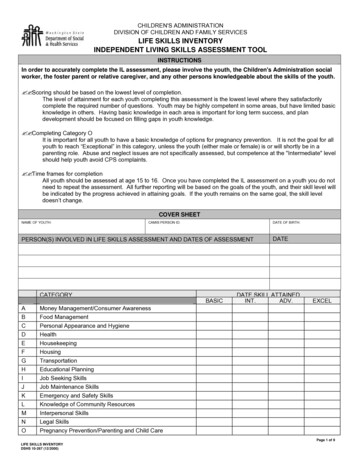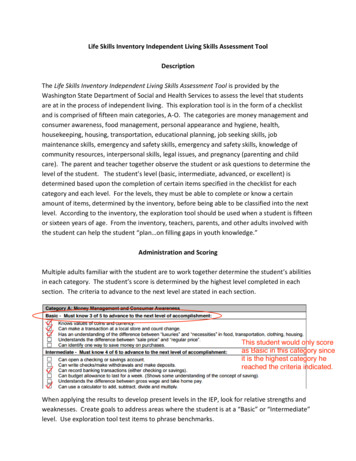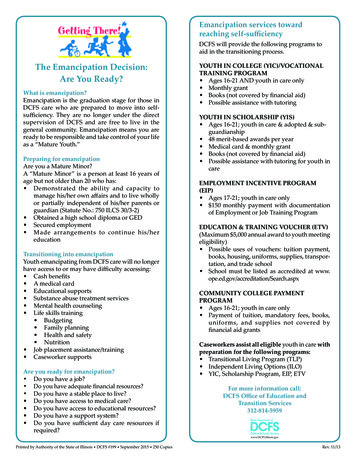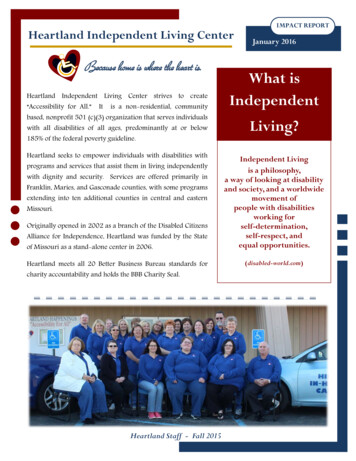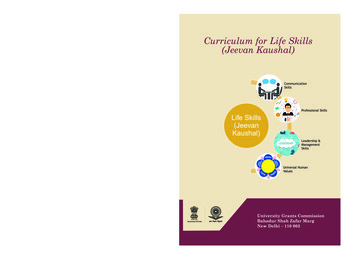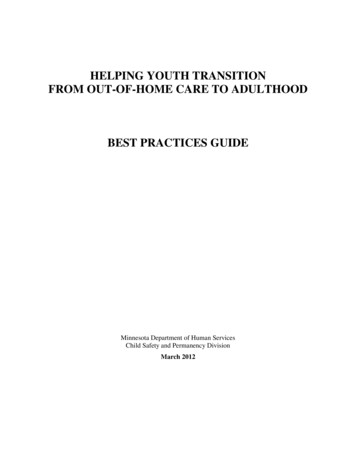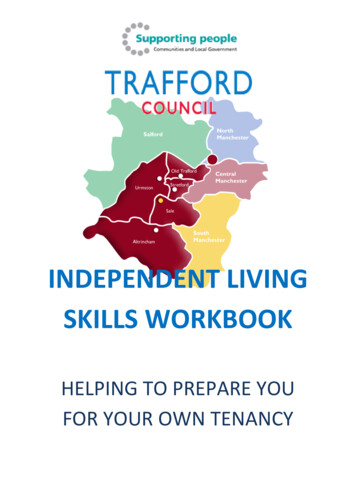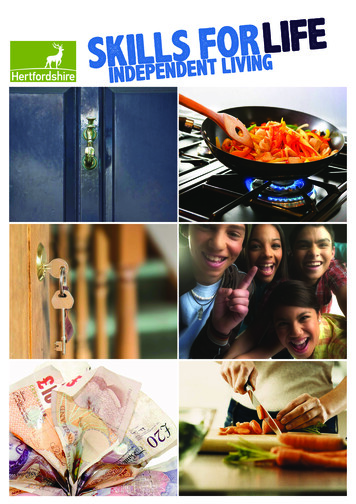
Transcription
Skills for Life - Independent LivingContentsSkills for Life - Independent Living Programme3Information about this resource4Starting the group7.Delivering the programme one-to-one11Session 1 – Healthy eating and food hygiene12Session 2 (part 1) – BudgetingSession 2 (part 2) –Option 1 – Internet & mobile safetyOption 2 – Drugs and alcoholOption 3 – Coping with loneliness2330Session 3 (part 1) – Becoming a tenant48.Session 3 (part 2) – Education and employment skills.Session 4 (part 1) – Debt advice58Session 4 (part 2) – Sexual health and positive relationships.Session 5 – Celebration68Evaluation toolEvaluation for carers / referrers71Accreditation information73Useful numbers and organisations in Hertfordshire79.Cooking together recipes (See additional PDF on CD)2
Skills for Life - Independent LivingSession oneHealthy living and food hygieneCooking togetherLeaving home/care – information and supportSession twoBudgeting skillsCooking togetherHealthy lifestyle choicesDrugs & alcoholOnline safetyCoping with lonelinessSession threeIndependent living – tenancy informationCooking togetherEducation and employment opportunitiesSession fourDebt adviceCooking togetherSexual health and positive relationshipsSession fiveCelebration sessionCooking together3
Information about this resourceSession oneHealthy living and food hygieneCooking is a recurring theme throughout this programme, with the young people preparingand cooking a meal together each session. As well as learning about basic kitchen hygieneand how to prepare food safely, there is a choice of recipes, including a vegetarian option,for all five dates. The facilitator version of these is towards the back of this pack.Additionally, as this course is all about developing young people’s independent living skills,there is a separate file on this CD-Rom that contains recipe sheets for all of the food cookedto download and print for each learner to take home and use. As well as recipes thiscontains some basic information about simple and healthy food to cook on a budget.The skills learnt can be accredited using an AQA Unit Award ‘Food handling and basiccooking skills’ (86161), details of which can be found in the accreditation section.Preparing to leave careThis session should be facilitated by an outside speaker with expert knowledge of theleaving home/care process in Hertfordshire. This could be a social worker or Targeted YouthSupport Personal Adviser, Foster Carers or Residential Home Workers.Session twoBudgetingBudgeting is an important skill for all young people to learn, but for those leaving home/careit will be essential that they know how to manage their money effectively.The activities in this section offer a basic introduction to income and expenditure andhow to set a basic budget for independent living. The skills learnt can be accreditedusing an AQA Unit Award ‘Budgeting skills’ (78538), details of which can be found in theaccreditation section.Healthy lifestyle choicesPlease be aware that both of the topics suggested for this section are too large to coverfully within the programme. Instead, the pack contains two introductory workshops withactivities that can either be used to fill one session, or woven in between other topics overthe four sessions. If young people have particular issues, or need additional support, pleaseensure that the information is available to signpost them to other services.Option 1 – Drugs and alcoholSuggested in this pack are some activities to offer information about drugs and alcoholand explore young people’s values and attitudes to substance misuse. Information aboutadditional services available to them should be handed out at the end of the meeting.4
Option 2 – Internet and mobile safetyThese session plans explore how young people use mobile phones and the Internet and aimto promote keeping young people safe online.Option 3 – Coping with lonelinessBeing alone is different to the loneliness felt by many young people leaving home/care. Thissession explores this and encourages young people to identify a network in the monthsleaving up to leaving home/care.Session threeBecoming a tenantThis is another session that should be facilitated by an outside speaker, this time onewith expert knowledge of housing support and housing for Independent Living Group inHertfordshire. This could include a social worker, Targeted Youth Support Personal Adviseror Herts Young Homeless Tenancy Support worker.Education and employment opportunitiesContained in this section are activities to explore the skills and qualities that employers andeducation providers look for in an applicant. They also explore young people’s values andattitudes to working and the motivation to action plan for the future.There is an opportunity to work towards an AQA Unit Award, ‘Introduction to actionplanning and goal setting’ (73046), details of which can be found in the accreditationsection.Session fourDebt adviceFor this session it is important that it is facilitated by an expert debt advisor, who canexplain to young people leaving home/care about the dangers of getting into debt and raiseawareness about where to go for financial help and support.Sexual health and positive relationshipsThis section contains a selection of activities to raise awareness about sexually transmittedinfections and promote positive relationships. There is no expectation that all of them willbe facilitated, especially as time is so limited, but instead that facilitators will choose thosemost appropriate to meet the needs of the group.Information should be made available at the end of the session about sexual healthservices, support for the victims and perpetrators of domestic violence and generalrelationship advice available to young people in Hertfordshire. This should include details ofthe local C-Card Scheme in the area and a an up-to-date copy of numbers u need.5
Session fiveThis session is a celebratory session that can be planned by facilitators to meet the needsof young people. If you plan an off-site trip then this will need to be organised using thestandard HCC risk assessments and consent forms.In this pack it is suggested that the celebration session will be a final group meal, and thereare recipes for cupcakes and a selection of sweet treats to make together to celebrate theend of the group.Recipes to useAll of the recipes suggested for the ‘cooking together’ part of each session are included atthe back of this pack in the section titled ‘Cooking Together Recipes’.‘Cooking Together Recipes’ are also available in a separate file to download and give toeach young person so that they can make the food again once they are living independently.These have been designed as recipe sheets, and come complete with an ingredients listand additional facts and common tips for healthy eating.6
Startingthgroupe
Creating a successful learning environmentThis resource pack shows the Independent Living Programme facilitated over five fourhours sessions, as per the pilot sessions run before the launch of this pack. These were setto coincide with mealtimes as preparing food and developing social skills is a key feature ofthe group, and held between 11 a.m. – 3 p.m. (during school holidays) or 4 p.m. – 8 p.m. interm-time.However, each session has been written as a stand-alone module, with a choice of activitiesto explore each topic so that facilitators can choose those that meet the needs of theyoung people best. For young people with additional needs, or those who find it difficultto concentrate for long periods of time, it is suggested that each session is split in half tocreate 8 x 2hour sessions and one celebration session at the end. Whilst this means thatthe group lifetime is longer, it may suit the learning needs of the young people better andresult in better participation and retention.For the pilot the group took place in youth centres and community venues with fullkitchen facilities. Whilst this has proved successful in bringing young people from differentresidential settings together, it is worth considering the option to facilitate the sessions insmall groups where the young people actually live. This provides the benefits of on-sitesupport and the option to deliver the training over a longer period, without the need toarrange transport or rely on young people to travel to the group independently.ReferralsAs this is a group that is open to young people by referral only, it is important for thesuccess and welfare of the whole group that referrers are encouraged to give detailedinformation about the young people they are referring, within the boundaries of professionalconfidentiality. This includes information and guidance about any – Additional learning support required Behavioural or emotional issues that require additional support Known relationships between the young people Known ‘triggers’ or coping strategies already in place for the young personThis is especially important as some of the topics covered, e.g. relationships, online safetyand bullying, are emotive and can result in young people needing additional support. Iffacilitators are made aware of potential difficulties then the programme can be adaptedto ensure that these are taken into account and young people can get the most out of thesessions.Finally, whilst diversity enriches any group experience, it is worth considering the learningabilities of the young people within the group. If you have young people from both ends ofthe spectrum it is suggested that these differing needs are taken into account and morethan one group run. That way, the pace of learning can be measured to suit participantsneeds and the appropriate level of support staff put in place.8
Ground rulesBefore starting, it is a good idea to produce a ‘contract’ or set of ground rules thateveryone, including the facilitator, is happy to work with. These are different to any rulesand regulations set by health and safety requirements, and are an agreement about howthe group will work together to get the most out of the sessions, and will form the basis of abehaviour contract that includes any sanctions put in place.As sensitive issues may be raised, especially in the session about drugs and alcohol ordiscussions around relationships, make sure that confidentiality and the need to respecteach others points of view and experiences are fully considered and everyone is clear aboutthe boundaries to acceptable and unacceptable behaviour.Eating together is a large part of this project aiming to offer young people the opportunityto learn to cook basic healthy recipes on a budget and learn about the preparation andhandling of food. To ensure that this is done safely, it is important to set clear guidelines forthe kitchen. Activity 3 & 4 within the plans for Session 1 offers ideas for discussing this indetail with young people, along with a suggested list of ‘Rules for the kitchen’ that can bedisplayed in the cooking area.ParticipationEncourage all members of the group to take part. It is often easier for quieter members toopt out of sessions rather than challenge the authority of more assertive young people. Thiscan result in a few strong characters dominating the whole group so ensure that everyonehas the opportunity to speak, but also reserve the right to ‘pass’ if someone finds a topicreally difficult to talk about. Leaving home/care is a big step and it is important that thereis support outside of group time for young people to ask further questions or continuediscussions begun during a session.Outside speakersIt is suggested that specialists within Hertfordshire County Council are invited in to speak tothe young people for the afternoon of Session 1 Leaving home/care whichever appropriate– information & support, Session 3 Living independently – tenancy information, and themorning of Session 4 Debt advice. However, this will depend on the expertise of thefacilitators.Accrediting the work doneThe Skills for Life - Independent Living programme offers opportunities for young people togain accreditation in some of the areas covered. Included in the ‘Accreditation’ section ofthis pack is the paperwork to support three AQA Unit Awards –AQA Unit Award Scheme – Food handling and basic cooking skills (Code no: 86161)AQA Unit Award Scheme – Introduction to action planning and goal setting (Code no: 73046AQA Unit Award Scheme – Budgeting skills (Code no: 78538)9
EvaluationThe process by which you plan to evaluate the success of the group will need to be decidedat the planning stage. There are aims for each activity included in this pack, and there is abasic evaluation tool after Session 5, which can be used in addition to any formal evaluationform. It is suggested that young people are encouraged to participate in a short evaluationat the end of each session so that they can reflect on their learning and experiences as wellas provide feedback to inform the planning for the next one.Feedback from carers / referrersTo ensure that carers and referring agencies can offer formal feedback about theprogramme an evaluation form has been included in the pack. This can add to the overallevaluation of the course and contribute to its ongoing development.After the sessionCheck that the room is clean and tidy, especially the kitchen area. This is an important partof the process of moving towards independence and offers another opportunity to reinforcesafety and hygiene guidelines.Useful numbers and organisations in HertfordshireAt the back of this pack is information about services for young people in Hertfordshire.These can be used to signpost young people on to additional support.10
Delivering the programme one-to-oneAlthough the Independent Living Skills programme has been written for group work, it iseasily adapted for support workers or foster carers to use in a one-to-one setting. This maybe more appropriate for young people with additional needs, or for those who work at aslower pace.So that young people get the most out of it instead of delivering the course in five sessions,spread the programme out over a longer time, only looking at one of the issue basedactivities and then preparing and cooking food to eat together each time.For example –Session one – basic kitchen hygieneSession two – basic food preparation and nutritionSession three – cooking on a budgetSession four – budgeting for independent livingSession five – becoming a good tenantSession six – keeping safe onlineSession seven – basic drug and alcohol awarenessSession eight – positive relationshipsSession nine – planning for the futureSession ten – applying for voluntary or paid employmentThe recipes in the ‘Cooking Together’ recipe book can be used, but extra attention shouldbe given to things like knife skills and using the cooker so that the young person can learnsafely and practise new skills several times under supervision. Once again, the emphasis ison teaching independence so it is better to repeat things and reinforce learning rather thanmoving on through the programme.Each session has been written as a stand-alone module so only select those mostappropriate to the young person, which can be done in any order. Some of the worksheetscan be used as discussion prompts, or as a question and answer session rather than beinga written exercise, dependent on the ability of the young person.Where an outside speaker is required or suggested, please speak to the young person’sHCC social worker or Targeted Youth Support Worker to ensure that this information isgiven. Much of the information about education and training opportunities will be availablefrom The Virtual School, details of which are available at ol/team/index.shtml11
Session One
Session 1Healthy eating and food hygieneIcebreaker: Desert island menuActivity 1: Healthy eating quizActivity 2: Healthy shopping basketActivity 3: Preparing to cookActivity 4: Safety in the kitchenActivity 5: AQA Food handling and basic cooking skills worksheet (outcomes 8 & 9)Preparing to leave care – outside speakerAsk the young person’s worker to suggest an appropriate speaker. It may be from theTargeted Support Service or Herts Young HomelessRecipe suggestions for session 1Homemade pizzaVegetable kebabsIcebreakerDesert island menuAimThis is a quick, simple introductory exercise to healthy eating that enables new groups tofind out about each other and reach group consensus through discussion.Time needed15 minutesYou will need Flipchart and markersHow to do itDivide the young people into groups of up to five; they then have a couple of minutes toconsider and decide three types of food that they would choose to live on for a year, ifstranded on a desert island, with nothing else to eat or drink apart from water. You candecide on any specific rules that you want to impose e.g. no alcohol or if they are allowedonly to choose from food that can be eaten raw.After considering their selection and reaching group agreement ask the young people towrite or draw their selection onto the flipchart paper. Finally, invite each group to share theirchoices and reasons for their selection, reminding them that there are no right or wronganswers.13
Reflect on the process of choosing and ask them to share how they managed to reachconsensus.Activity 1Healthy eating quizAimThe aim of this quiz is to give basic, correct information so that young people can begin tomake informed choices about their diet.Time needed15 minutesYou will need Copies of the quiz Pens Support leaflets and information(in case the session raises questions you can’t answer)How to do itHand out copies of the questionnaire to each group member, or ask them to work in pairs.Allow about ten to fifteen minutes for them to look at the questions and consider theiranswers.Go through the questions and answers with the group discussing responses.Reinforce healthy eating options and the need for a balanced diet and regular exercise,handing out leaflets where appropriate.ANSWERS – 1c, 2a, 3c, 4b, 5b, 6a, 7c, 8b, 9c, 10bSource - www.mindbodysoul.gov.uk14
Healthy eating quiz1.There are two main types of food ‘good’ and ‘bad’a)Vegetarian food is ‘good’ food and by far the healthiest option; everyone would be farhealthier if they just gave up eating meat.To be healthy you should give up eating ‘bad’ food like chips and bread and eat ‘good’food like lentils and beansNo food is ‘good’ or ‘bad’. The important bit is to balance food from the five foodgroups – including 5 x portions of fruit and vegetables a dayb)c)2.Eating carbohydrates like bread, potatoes and pasta makes you put on weighta)c)No - these foods help fill you up and give you energy. Take care how you cook them –e.g. frying or adding too much butter. It is the fat you add that increases the calories,and can lead to putting on weightYes - these foods should be avoided, as they are high in calories and low in nutritionalvalueYes - these foods are high in fat so should be limited to once a week3.100g French Fries contain more fat than a jacket potatoa)True - 100g French Fries contains 20g fat compared to 100g baked potato that containsless than1gTrue – but only just! 100g of French Fries contains 3g of fat compared to a 100g bakedpotato that contains 2gTrue - 100g French Fries contains 15g fat compared to a 100g jacket potato thatcontains less than 1gb)b)c)4. There is no point in drinking skimmed milk – all the goodness has been takenout of it!a)b)c)Skimmed milk has less calcium and protein than whole milk, as it is lost in the skimmingprocessAll milk is a good source of calcium & protein. When milk is skimmed it is only fat that isremovedDuring the skimming process the milk is heated to boiling point before being cooled inhuge coolers. It is during this process that protein is destroyed although there is stillcalcium left in the milk.5.Frozen vegetables don’t count towards the recommended five portions of fruit andvegetables you should eat a daya)b)c)True – most of the vitamins are destroyed in the freezing processFalse – frozen vegetables all retain their vitamins and minerals when they are frozenDepends – on which vegetables and fruit it is, freezing, destroys the vitamins in somedelicate vegetables, such as peas. This means you would have to eat four times theamount of frozen peas to get the same amount of vitamins and minerals in a portion offresh peas.15
6.Which of these are ‘oily’ fish and a good source of unsaturated (Omega 3) fats thatcan help protect the heart and circulatory system?a)b)c)SalmonCodTuna7. It is best to take vitamin supplements to make sure you get enough vitamins dailya)b)c)Yes – no matter how well you eat you can never have too many vitaminsIt is a good way to avoid being ill by boosting the number of vitamins you take dailyIf you eat a balanced, varied diet you shouldn’t need to take anything extra to keep youhealthy8.Very low calorie diets are an excellent way to loose weight fast.a)b)True – eat three low calorie ready meals a day and you will be thinner and healthierFalse – very low calorie diets don’t provide enough energy for healthy growth andready meals can contain way too much salt. Eat a healthy balanced diet and increaseexercise by regularly doing activities you enjoy like dancing, walking and playing sport.False – ready meals are too expensivec)9.If the weather is hot you should add more salt to your food to make up for the saltlost through sweatinga)b)c)Only if you like saltOnly rock sea salt, as this is purerMost UK diets include more salt than the body needs so even in hot weather you don’tneed extra10. Adding bran to food is a good way to get enough fiber in your dieta)b)c)16True – it is really good for your digestionNot a good idea as it may upset your stomach. It is better to choose wholemeal pasta,bread and eat plenty of fruit, vegetables and pulses such as beans and lentils.True – you can’t really have too much fiber in your diet
Activity 2Healthy shopping basketAimThis activity introduces the topic of cooking on a budget and compares the cost of healthyfood with takeaway meals.Time needed30 minutesYou will need Copies of the ‘Healthy Shopping Basket’ worksheet Online access A good selection of takeaway menus Paper and pensHow to do itSuggest that one of the most important skills to learn for independent living is how to shopfor healthy food on a budget. Divide the young people into pairs and hand out a worksheetto each couple. They now have ten minutes to fill it with healthy food up to the value of 20.They should write an estimated cost of each item next to the word or drawing. The foodshould be something that they would eat, rather than just things that they know are goodfor them. For example, lentils are cheap, filling and nutritious, but a very bad buy if you hatethem and they will simply sit in a cupboard!Call time and ask each pair to tell the main group the contents of their basket, along withtheir estimated costs. After each round invite the rest of the group to say whether they thinkthe actual cost would be higher or lower than anticipated.Using the website of any supermarket, the young people can then discover the real price ofthe food chosen, and note down how far out their guesses are. The couple with the nearestprice match can choose the menu for the following week, either from the suggestions in thispack or from recipes they already know.Finally, hand out the takeaway menus and again invite each couple to choose what theywould normally order, noting down the costs. Once this is done, facilitate a discussion thatconsiders –The price of a takeaway compared to buying food straight from a supermarket, market orshopThe nutritional value of a takeawayWays to make a healthy alternative17
Conclude that takeaways, especially when living within a tight budget, should be viewed asan occasional treat, rather than a preferable option to cooking.Healthy Shopping basket worksheetFill the basket with 20 worth of healthy food that you enjoy eating. Draw or write the nameof the food and then write the price next to each item.18
Activity 3Preparing to cookAimThis activity aims to help young people understand about basic food hygiene and preparingto cook.Time needed20 minutesYou will need Flipchart paper and markersHow to do itStart by setting some ground rules for the kitchen. Do this by explaining how important itis to maintain health and safety in the kitchen and make sure food is safe to eat. Write aheading ‘Safe kitchens, safe food’ on a sheet of flipchart paper and invite the young peopleto call out ideas of what needs to be done to prepare for cooking. Ideas might include Safe Kitchens, Safe Food Hands must be washed for at least 20 seconds in hot water with soap Hair should be tied back (if long) Aprons should be worn Make sure that all cooking surfaces and all equipment are clean Check the dates on all of the food and that it has been stored correctly Thoroughly wash all fresh vegetables and fruits in cold water Handle knives correctly – e.g. don’t walk around with them Use the correct colour coded chopping board to avoid food cross-contamination Re-wash hands in between preparing food Store any left over food correctly
Activity 4Safety in the kitchenAimThis is an alternative to Activity 3 for introducing health and safety issues that arise whilstcooking and preparing food.Time needed20 minutesYou will need Flipchart paper and markersHow to do itFacilitate this as a whole group activity, or by dividing the main group into pairs. Ask theyoung people to make a list of things found in the kitchen that might prove to be dangerousor may cause accidents. They should jot down as many as they can in three minutes andbe prepared to explain how or why they think their suggestions could cause harm.This should include KnivesSaucepansPetsMatchesCookers – hobs, oven & sClothing (high heels, long sleeves, long hair etc.)WiringPlugs, socketsEquipment, e.g. a blender, toasted sandwich maker or kettleCleaning materials, e.g. bleachGet feedback from groups, discuss answers and then write up answers on flipchart paperunder four headings: Food Preparation, Electrical equipment, Floor, Others.Point out that accidents can, and do, happen to anyone, but some groups are morevulnerable than others, for example children or the elderly. Suggest that there are alsoprecautions that can be taken to reduce risk and make the kitchen a safer place.20
Introduce the rules of the kitchen – Wash hands before, during and after preparing foodTie long hair back and roll up long sleevesClean all surface areas before and after preparing foodWear aprons whilst cookingWear gloves whilst handling raw foodNo cooking unsupervisedUse different chopping boards for different foodsTake off jewellery and cover any cuts or things like piercings and new tattoosAlways use a separate spoon for tasting—never the same one you are using for stirring.Use a separate towel for drying your hands and drying up.No smoking in or around the kitchenNo cooking whilst under the influence of drugs or alcoholWipe up any spills or liquids on the floor to avoid slippingTake care whilst using hot cooking utensilsIf you have been ill in the 24 hours before the cooking session please inform the facilitator –you may not be able to cook that day.21
Activity 5Food Handling and Basic Cooking Skills WorksheetAimThis is a worksheet to use to evidence learning for Outcomes 8 & 9 of AQA Unit Award,‘Food Handling and basic cooking skills’.Time needed15 minutesYou will need A copy of the worksheet and a pen for each learner Laptop, projector and speakersHow to do itFacilitate a review discussion of the learning so far, in particular the areas covered on theworksheet.Show this YouTube video, ‘Jamie Oliver Home Cooking Skills’ http://www.youtube.com/watch?v IA8IW5abQTgAs they watch the video the young people should call out all the things that they seethe young woman in the video doing that are either dangerous or a hazard to health andhygiene. Young people can either complete the worksheet as they talk, or it can be filled inafterwards.Collect the worksheets in ready to go with the AQA Summary Sheet for this unit to beassessed.22
Independent Living GroupAQA Unit Award SchemeUnit: Food Handling and Basic Cooking SkillsUnit Code: 86161Outcomes: 8 & 9Name . Date .Outcome 8Five basic facts about food hygiene:a) .
the young people for the afternoon of Session 1 Leaving home/care whichever appropriate – information & support, Session 3 Living independently – tenancy information, and the morning of Session 4 Debt advice. However, this will depend on the expertise of
